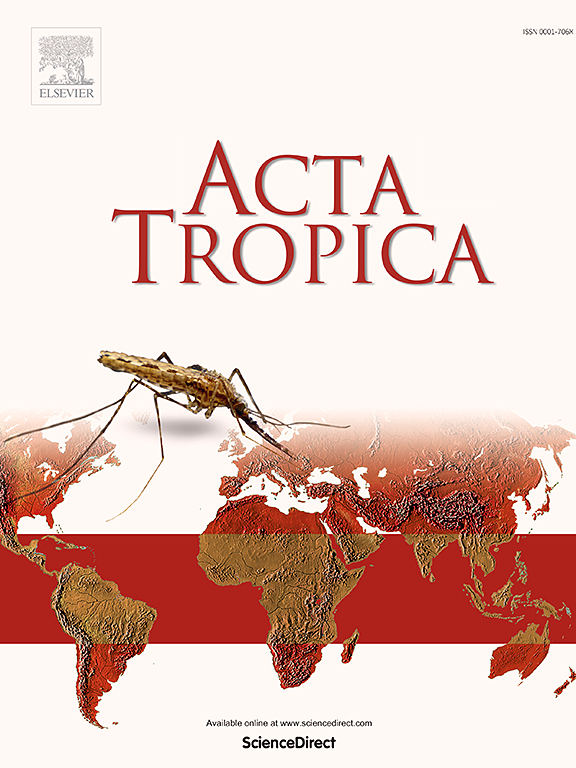Melioidosis in people living with diabetes; clinical presentation, clinical course and implications for patient management
IF 2.1
3区 医学
Q2 PARASITOLOGY
引用次数: 0
Abstract
Background
Despite the well-established link between diabetes mellitus and melioidosis, the precise impact of diabetes, its complications, and its therapy on the presentation and clinical course of melioidosis is incompletely defined. The influence of glycaemic control on the diverse clinical manifestations and the clinical course of melioidosis in patients with diabetes has also not been examined in detail.
Methods
We examined all cases of culture-confirmed melioidosis in Far North Queensland, Australia between October 1, 2016, and April 30, 2024. We hoped to define the impact of diabetes, its control and its therapy on the patients’ presentation and their clinical course.
Results
There were 321 cases of culture-confirmed melioidosis during the study period; the patients’ median (interquartile range (IQR)) age was 57 (46–69) years, 212/321 (66 %) were male, 130/321 (41 %) identified as First Nations Australians. Diabetes was the most common risk factor for melioidosis in the cohort (163/321, 51 %); in 19/163 (12 %) this was a new diagnosis. The median (IQR)) glycosylated haemoglobin prior to presentation was 9.1 % (7.2–11.5) and 96/162 (59 %) with complete data had established macrovascular or microvascular complications. People with diabetes were more likely – than people without diabetes – to have involvement of the liver (odds ratio (OR) 95 % confidence interval (CI): 9.68 (2.21–42.46), p = 0.003), the spleen (OR (95 % CI): 7.32 (1.64–32.80), p = 0.009) or to have disseminated disease (OR (95 % CI): 2.93 (1.26–6.78), p = 0.01). However, people with diabetes were no more likely than people without diabetes to require intensive care unit admission (OR (95 % CI): 0.82 (0.47–1.42), p = 0.48) or to die before hospital discharge (12/163 (7 %) versus 19/158 (12 %), OR (95 % CI): 0.58 (0.27–1.24), p = 0.16). Only 58/163 (36 %) with diabetes had specialist endocrinology review during their hospitalisation and only 22/72 (31 %) with accessible data had good glycaemic control (glycosylated haemoglobin ≤7 %) in the 12 months after discharge, increasing their risk of subsequent diabetic complications. Of the 151 people with diabetes surviving their hospitalisation, 26 (17 %) died, at a median (IQR) of 1.0 (0.40–4.1) years after discharge. Of the individuals with diabetes who had completed five years of follow up, 21/60 (35 %) had died at a median (IQR) age of 67 (51–84) years.
Conclusions
Individuals with diabetes and melioidosis are more likely to have liver and spleen abscesses and disseminated disease than individuals without diabetes, manifestations that appear to be linked directly to glycaemic control. In Australia's well-resourced health system <10 % of patients with diabetes and melioidosis will die from their infection. However, five-year all-cause mortality in individuals with diabetes who survive their melioidosis is greater than 30 %, emphasising the importance of close, holistic multidisciplinary follow-up to ensure their optimal long-term health outcomes.

背景:尽管糖尿病与类鼻疽之间的联系已得到证实,但糖尿病及其并发症和治疗对类鼻疽的表现和临床过程的确切影响尚未完全明确。血糖控制对糖尿病患者不同临床表现和类鼻疽临床病程的影响也尚未得到详细研究:我们研究了2016年10月1日至2024年4月30日期间澳大利亚昆士兰州远北地区经培养确诊的所有瓜虫病病例。我们希望明确糖尿病、糖尿病控制和治疗对患者发病和临床病程的影响:在研究期间,共有321例经文化确诊的类鼻疽病例;患者的中位数(四分位数间距,IQR)年龄为57(46-69)岁,212/321(66%)例为男性,130/321(41%)例确定为澳大利亚原住民。糖尿病是队列中最常见的类鼻疽风险因素(163/321,51%);19/163(12%)人是新诊断出的糖尿病患者。发病前的糖化血红蛋白中位数(IQR)为 9.1% (7.2-11.5),96/162(59%)名数据完整的患者已出现大血管或微血管并发症。与非糖尿病患者相比,糖尿病患者更有可能累及肝脏(比值比 (OR) 95% 置信区间 (CI):9.68 (2.21-42.46),p=0.003)、脾脏(比值比 (OR) 95% 置信区间 (CI):7.32 (1.64-32.80),p=0.009)或播散性疾病(比值比 (OR) 95% 置信区间 (CI):2.93 (1.26-6.78),p=0.01)。然而,糖尿病患者需要入住重症监护室(OR (95% CI):0.82 (0.47-1.42),p=0.48)或在出院前死亡(12/163 (7%) 对 19/158 (12%),OR (95% CI):0.58 (0.27-1.24),p=0.16)的几率并不比非糖尿病患者高。只有58/163(36%)名糖尿病患者在住院期间接受了内分泌专科复查,只有22/72(31%)名患者在出院后的12个月内血糖控制良好(糖化血红蛋白≤7%),这增加了他们随后出现糖尿病并发症的风险。在 151 名住院期间存活的糖尿病患者中,有 26 人(17%)在出院后 1.0 年(0.40-4.1)的中位数(IQR)死亡。在完成五年随访的糖尿病患者中,21/60(35%)人死亡,中位数(IQR)年龄为 67(51-84)岁:结论:与非糖尿病患者相比,糖尿病合并类鼻疽患者更容易出现肝脾脓肿和播散性疾病,这些表现似乎与血糖控制直接相关。在澳大利亚资源丰富的医疗系统中,只有不到10%的糖尿病和类鼻疽患者死于感染。然而,糖尿病患者在胰岛素瘤病存活后的五年全因死亡率超过了30%,这就强调了密切、全面的多学科随访对确保患者获得最佳长期健康结果的重要性。
本文章由计算机程序翻译,如有差异,请以英文原文为准。
求助全文
约1分钟内获得全文
求助全文
来源期刊

Acta tropica
医学-寄生虫学
CiteScore
5.40
自引率
11.10%
发文量
383
审稿时长
37 days
期刊介绍:
Acta Tropica, is an international journal on infectious diseases that covers public health sciences and biomedical research with particular emphasis on topics relevant to human and animal health in the tropics and the subtropics.
 求助内容:
求助内容: 应助结果提醒方式:
应助结果提醒方式:


